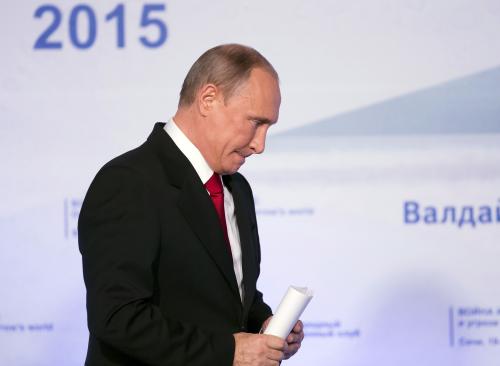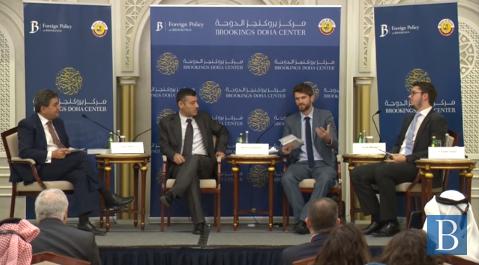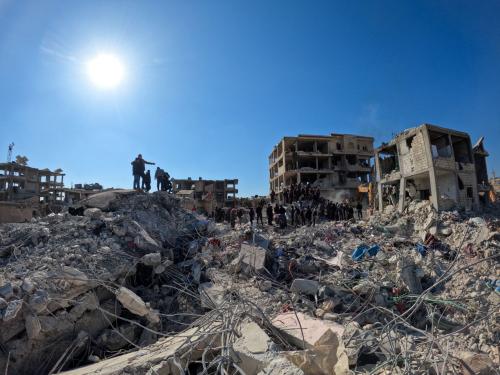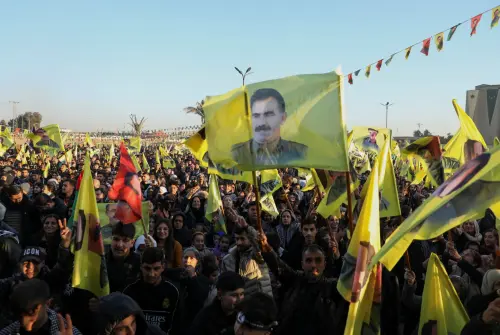This month marks the seven-year anniversary of the war in Syria, by far the world’s deadliest ongoing conflict. It is also the six-year anniversary of United Nations-led peace talks. Over the last four months, three Syrian peace initiatives have moved ahead. Indeed, the apparent military defeat of the Islamic State in Syria (ISIS) and the return to a peace process focused on forging a political solution to the conflict seem like hopeful signs for the stabilization of Syria.
However, these peace initiatives have each failed to make progress, and there have been renewed military offensives by the Bashar Assad regime against opposition-held territory. The situation appears chaotic and peace seems much farther off than it did in October 2017, when Raqqa, the ISIS capital, fell and four “de-escalation zones” were established.
Throughout the war, peace talks have focused on a government of unity, but no bilateral actors have seriously supported that idea. This has left the regime, the opposition, and a shifting configuration of international actors to battle over territory. Despite the potentially ripe moment for peace last fall, with ISIS defeated and an agreement in place to forestall clashes between the regime and opposition forces in some areas, 2018 seems like it will be focused much more on military victories than negotiated settlement. Moving peace forward requires prioritizing the U.N.-sponsored process among the various international actors.
Despite the potentially ripe moment for peace last fall, 2018 seems like it will be focused much more on military victories than negotiated settlement.
ORIGINS OF THE PEACE TALKS
The United Nations’ peace process, the so-called Geneva talks, are the longest running and most legitimate vehicle for peacemaking in Syria. This process was born out of the 2012 failure of Kofi Annan’s six-point plan for a ceasefire and the demilitarization of the Syrian war.
In February 2012, the Arab League and United Nations jointly appointed Kofi Annan as their envoy for Syrian peacemaking. He quickly had the backing of the U.N. Security Council, the Syrian government, and the Free Syrian Army for a ceasefire. That ceasefire went into effect on April 10, 2012 and lasted just long enough to deploy the U.N. Supervision Mission in Syria (UNSMIS). The mission had a weak mandate and consisted of close to 300 unarmed military observers.
Members of the U.N. Security Council had proposed a series of resolutions that called for sanctions against the Syrian regime and Assad’s removal in late 2011 and early 2012. Russia and China vetoed three such resolutions before agreeing to UNSMIS.
Following the ceasefire, Annan convened the Geneva I Conference on Syria in June 2012. That conference set out a political path forward, calling for the formation of a power-sharing government that would include the regime and the opposition.
By August 2012, the Annan initiatives had failed. Annan stepped down, UNSMIS was disbanded, and violence continued to escalate. The one point from Annan’s proposals with staying power was the negotiations between the Syrian regime and the opposition.
Two weeks after Annan’s resignation, the Obama administration declared that Assad could not legitimately remain Syria’s president. This policy gave Assad an existential reason not to engage in negotiations over power-sharing, presuming that the United States would only support a resolution that did not include the Syrian leader. It also gave international stakeholders reason to doubt U.S. backing of the Geneva talks.
Syrian and international actors embraced the process of the Geneva talks, but not the premise of forming a unified, transitional government. Fighting continued, with both sides trying to gain an advantage in negotiations to come—or obviate the need for them.
Geneva II talks were held in January 2014, with the goal of establishing a way forward for talks, but quickly failed. Negotiations were undermined by two basic factors.
First, there was no agreement over which groups should be included in the Syrian opposition. Syrian Kurdish groups were largely kept out, as were Islamists. The exile group that represented the opposition at the Geneva II talks had little connection to or control over actual fighters on the ground.
Second, Assad had little reason to engage in talks given the U.S. policy that he should be removed from power. Rather, the regime was incentivized to continue to fight instead of negotiate.
Soon after the failure of Geneva II, ISIS swept through Syria and then into Iraq, seizing territory and focusing international attention on warfighting against the terrorist group rather than peacemaking between the Syrian government and the opposition. The United States increased its support to rebels and put together a coalition of states to fight ISIS in the fall of 2014.
In 2015, Russia intervened in the war, giving the regime a decisive edge over the opposition. In coordination with the Syrian government, Russia deployed troops and offered air support to the regime’s campaign against ISIS. The anti-ISIS coalition and the Russian intervention increased the stakes for external stakeholders and deepened relationships with opposing sides in the civil war.
GENEVA AND VIENNA
Efforts to make peace were put on hold while the battle against ISIS escalated. It was not until the fall of 2015 that international stakeholders made another concerted effort at negotiations. Given Russia’s commitment to the war at that time, Moscow has since then made efforts to influence the peace process.
In October and November of that year, the International Syria Support Group, consisting of 20 states and international organizations—controversially including Iran—set out a blueprint for moving Syrian peace forward in the Vienna Statement. This was endorsed with U.N. Security Council resolution 2254. In keeping with the formulation of the 2012 Geneva talks, resolution 2254 called for a January start to negotiations between the opposition and government, and elections within six months for a unity government.
There was a flurry of initiatives focused on bringing a unified and representative Syrian opposition to the table in response to resolution 2254. December 2015 discussions in Riyadh resulted in the formation of the opposition’s High Negotiations Committee, which elected representatives to participate in the talks mandated by resolution 2254.
Predictably, Syrian Kurds were excluded at the insistence of Turkey. In addition, the most powerful Islamist opposition group refused to sign on. Serious divisions remain within the Syrian opposition, while international stakeholders back or exclude a variety of factions, based on their own interests.
Geneva III talks were convened in early 2016, but were quickly suspended due to government offensives, with Russian and Iranian support, against rebel-held territory around Aleppo. The regime was seeking to dictate the facts on the ground, at least partially in response to the incentives of the peace process.
ASTANA AND GENEVA IV
Throughout the spring and summer of 2017, given progress against ISIS and with an eye toward post-ISIS stabilization, two parallel sets of talks progressed: Geneva IV, between the Syrian government and the High Negotiations Committee, under the auspices of the United Nations; and the Astana talks, indirect negotiations between the regime and the opposition, with Russia, Turkey, and Iran acting as sponsors.
Russia’s initiatives to organize talks outside of the Geneva process could provide the Syrian regime an opportunity to venue shop by playing to two processes off of one another, thereby undermining the multilateral process. The January talks in Sochi were heavily tilted toward the regime and its chosen participants.
Astana’s contribution to this crowded field was to bring opposition groups that represented combatants into discussion with the regime. As such, it was focused on bringing about a ceasefire. And indeed, just as ISIS had been defeated, the Astana talks seemed to bear fruit.
At the end of October 2017, four “de-escalation” zones were established, which were supposed to deliver a six-month ceasefire to opposition-held territory. A pause in fighting between the regime and the opposition at the same time as the end to fighting against ISIS would have been a significant boon to moving a political process forward through Geneva IV.
Those four zones included (1) parts of Idlib, Latakia, and Aleppo provinces, (2) an enclave in northern Homs province, (3) eastern Gouta near Damascus, and (4) areas of the Derra and Quneitra provinces—most of the remaining territory held by opposition groups. Each zone is guaranteed by different international sponsors. However, it also appeared from the outset of negotiations in May that the strategy would allow for the containment and defeat of some opposition areas.
The Syrian regime quickly attacked the zones in Idlib and eastern Gouta. Attacks have been characterized by violence against civilians, including indiscriminate aerial bombings and chemical weapons attacks.
The current violence in eastern Gouta has been extreme. A U.N. Security Council resolution calling for a cessation of hostilities and the establishment of a humanitarian corridor has so far failed to do much to protect civilians.
In the context of this violence, the United Nations pushed forward with the Geneva IV talks. After offensives in Idlib began, but prior to the violence in Gouta, the December negotiations quickly collapsed. Given insufficient international pressure to participate and the possibility of military progress, the Syrian regime failed to engage with the process.
International support for a peace process seems dismally fractured.
WHAT TO EXPECT
At the moment, it seems that prospects for peace in Syria through a negotiated settlement are dim. It appears as if the Syrian regime intends to regain control of some or all of the rebel-held territory. That is quite a bit of land, and therefore this year might be characterized by more horrific violence targeting civilians.
International support for a peace process, and necessary pressure on the regime and opposition groups, seems dismally fractured. Turkey is now pursuing its conflict with the Kurds that straddles the border between Turkey and Syria. Russia sponsored the regime-dominated Sochi alternative peace conference, although that too lasted only briefly and produced little. The United States’ policy toward Syria ought to be re-focused and do more than it is currently proposing.
There are two possible routes forward. One is through power sharing and political transition, most likely to be achieved through multilateral support for the Geneva talks. The other is the military defeat of the opposition. If the Geneva process is the preferred outcome, then the United States should support U.N. efforts without pre-judging the outcome. If peace is the goal in Syria, coordination rather than competition with international stakeholders has to be prioritized. The most meaningful contribution multilaterally could be re-asserting the primacy of the United Nations’ efforts.
The Brookings Institution is committed to quality, independence, and impact.
We are supported by a diverse array of funders. In line with our values and policies, each Brookings publication represents the sole views of its author(s).











Commentary
7 years into the Syrian war, is there a way out?
March 16, 2018